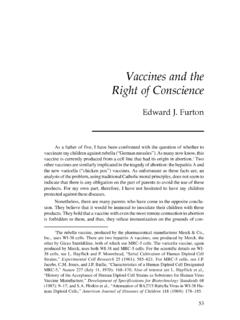Transcription of Vitamin A deficiency - WHO
1 SummaryVitamin A deficiency is a common form of micronutrient malnutritionaffecting of preschool-age children and of pregnant published literature linking Vitamin A interventions to cause-specific child mortality due to measles, diarrhoea, malaria and other infec-tious diseases and to all-cause maternal mortality was comprehensivelyreviewed. Randomized controlled trial data of Vitamin A interventionsand survival were used to estimate the risk of mortality associated withvitamin A deficiency . The published relative risks were adjusted for theestimated prevalence of deficiency at study baseline. Summary relativerisks were calculated from meta-analyses (for measles, diarrhoea, andother infectious disease causes of child mortality) or from single studies(malaria mortality among children and all-cause maternal mortality).The estimated relative risks associated with Vitamin A deficiency inchildren were (95% CI ) for measles mortality, (95% CI ) for diarrhoea mortality, (95% CI )for malaria mortality, (95% CI ) for other infectiousdisease mortality and (95% CI ) for all-cause available evidence suggests that nearly 800 000 deaths worldwidecan be attributed to Vitamin A deficiency among women and 20 24% of child mortality from measles, diarrhoea andmalaria and 20% of all-cause maternal mortality can be attributed tothis preventable condition.
2 Africa and South-East Asia have the highestburden of 4 Vitamin A deficiencyAmy L. Rice, Keith P. West Jr. and Robert E. objective of this chapter is to summarize the available evidence thatcan be used to quantitativelyestimate the risk of adverse health outcomesassociated with Vitamin A deficiency and to calculate the associatedburden of disease for different regions of the world. Vitamin A is anessential nutrient required for maintaining immune function, eye health,vision, growth and survival in human beings. Over the years, numerousstudies have been conducted to identify the biological functions ofvitamin A, the health consequences associated with deficiency , and themechanisms that explain these relationships. Causal relationships havebeen clearly demonstrated in some instances and comprehensive reviewson the subject have been published (Sommer and West 1996).According to World Bank estimates, Vitamin A supplementation forpreschool-age children is one of the most cost-effective child survivalinterventions (World Bank 1993).
3 National level public health pro-grammes to prevent and treat Vitamin A deficiency are currently beingimplemented in countries in Asia, Africa and elsewhere. Internationaldonors and agencies including the Canadian International DevelopmentAgency (CIDA), United Nations Children s Fund (UNICEF), the UnitedStates Agency for International Development (USAID), the World HealthOrganization (WHO) and others have actively supported both nationaland global level initiatives to raise awareness about the problem ofvitamin A deficiency and to promote efforts to implement effective andaffordable solutions (Mason et al. 2001). Reducing the prevalence ofvitamin A deficiency will lessen disease burden by improving immunefunction, lowering mortality rates and preventing blindness, especiallyamong children. This chapter will contribute to ongoing efforts to assessthe global problem of Vitamin A deficiency by using existing data to esti-mate global prevalence rates, to identify and quantify the adverse healthconsequences associated with deficiency , and to estimate the future healthbenefits that could be gained by implementing even more effectivecontrol of malnutrition and Vitamin A deficiencyMalnutrition is a complex phenomenon.
4 Broadly defined, malnutritionrefers to the condition of inappropriate nutrition. In the past, discussionsof malnutrition in the context of health issues in low-income countriesoften used this term to refer to the condition of undernutrition asso-ciated with what was presumed to be protein energy malnutrition andoperationally defined as a deficit in anthropometric status or by the pre-sence of clinical signs such as oedema or altered hair colour. In morerecent years, various Vitamin and mineral deficiencies, including vitaminA, iron, iodine and zinc have been recognized as discrete types of mal-212 Comparative Quantification of Health Risksnutrition that adversely affect human health and contribute to diseaseand mortality. Some of these nutrients affect closely related biologicalsystems; for example both Vitamin A and zinc play important roles inmaintaining different aspects of immune function (Shankar 2001) andboth Vitamin A and iron affect haemoglobin metabolism (Semba andBloem 2002).
5 Ecological-level studies have demonstrated that the pre-valence of these micronutrient deficiencies are high in many of the samecountries, thus many individuals may suffer from multiple micronutri-ent deficiencies at the same time. However, relatively few data are cur-rently available for quantifying either the joint distribution of multipledeficiencies or the impact that multiple micronutrient deficiencies haveon specific health outcomes. Therefore, the comparative risk assessment(CRA) project will estimate the separate contribution of these risk factorsto the global burden of disease. Individual reviews are available for therisk factors of iron deficiency (chapter 3), zinc deficiency (chapter 5) andunderweight status (chapter 2) in addition to Vitamin A deficiency , whichis the subject of the current chapter. Vitamin A is an essential nutrient required for maintaining immunefunction, eye health, vision, growth and survival in human beings(National Research Council 1989).
6 Although animal studies that identi-fied Vitamin A as a necessary factor for rat growth were conducted inthe early 1900s and the chemical structure of the Vitamin was elucidatedover 20 years later, reports describing the link between xerophthalmia(signs in the eye of disease due to a severe lack of the Vitamin ) and suc-cessful treatment with animal liver (a rich source of the Vitamin ) dateback to the medical writings of ancient Egypt (Olson 1996).At present, Vitamin A deficiency remains a widespread public healthproblem, especially in countries of South Asia and Africa. Globally,preschool-age children and women of reproductive age are the two population groups most commonly recognized to be at risk of this nutritional deficiency and its adverse health consequences. A combina-tion of chronically lower than required dietary intakes of Vitamin A-rich foods (eggs, milk, liver, deep orange fruits and dark green leafyvegetables, etc.)
7 Combined with malabsorption and increased Vitamin Aexcretion rates associated with some common illnesses places manywomen and children at risk of developing Vitamin A deficiency (Christian et al. 1998b; IVACG 1997; Sommer and West 1996;Stephensen 2001).No single indicator can be reliably used to assess the full spectrum ofvitamin A deficiency . Different aspects of Vitamin A status are assessedusing clinical indicators, biochemical indicators, functional indicatorsand histological indicators (WHO 1996). In humans, Vitamin A is storedalmost exclusively (>90%) in the liver and some investigators proposeliver and/or total body stores as a primary indicator of Vitamin A recent isotope dilution techniques to indirectly measure livervitamin A stores have yielded promising results (Haskell et al. 1999;Amy L. Rice et et al. 1999) these techniques have not yet been used inlarge-scale population-based Vitamin A deficiency can be identified by the presence of theclassical eye signs of xerophthalmia in individuals.
8 However, becausesevere Vitamin A deficiency is relatively rare in most populations, a largenumber of individuals must be surveyed in order to generate a reliableprevalence estimate. Depending on the severity of Vitamin A deficiencyin a population, the sample size requirement for a xerophthalmia surveymay be nearly ten times higher than what would be required to generate a reliable prevalence estimate for other indicators of Vitamin Astatus, such as low serum retinol concentrations, which may occur morefrequently in the same population (Sommer and Davidson 2002; WHO1996).Milder Vitamin A deficiency is far more common, but the assessmentof Vitamin A deficiency that does not result in relatively easily observ-able eye signs is also more problematic. One way to identify milder formsof Vitamin A deficiency is to collect blood samples and measure the concentration of circulating serum retinol in an individual.
9 Values< have traditionally been considered indicative of deficiencyin children, based on empirical data from population-based studies thatdid not exclude individuals based on measurements of acute phase pro-teins. In adults, appropriate cut-off levels are less firmly established, butvalues < and < have been used for different pur-poses. Because serum retinol concentrations are transiently depressedduring the acute phase response to certain infections, some investigatorshave questioned the validity of using this indicator to assess the vitaminA status of individuals (Stephensen 2001). However, determining theprevalence of serum retinol concentrations below a defined cut-off pointremains one of the most commonly used and widely accepted approachesfor assessing the Vitamin A status of entire populations (Sommer andDavidson 2002).At the population level, the prevalence of Vitamin A deficiency can bedetermined based on the prevalence of either: (i) night blindness, usuallyobtained by verbal recall; (ii) other eye signs of xerophthalmia (Bitot sspots or corneal lesions); or (iii) biochemical indicator values (serumretinol, breast milk retinol, relative dose-response test, modified relativedose-response test, or serum 30-day response), or histological indicatorvalues (conjunctival impression cytology [CIC] that fall below a definedcut-off point (WHO 1996).)
10 Until recently the majority of nationally rep-resentative, large-scale surveys related to Vitamin A deficiency were con-ducted primarily among preschool-age children. However, in the past fewyears some large-scale surveys, including recent demographic and healthsurveys, have also attempted to estimate the prevalence of night blind-ness among pregnant women. More limited survey findings are availablefor serum and breast milk retinol concentrations among women. Surveysthat included data on any or all of the indicators listed above were used214 Comparative Quantification of Health Risksas a basis for estimating the global prevalence of Vitamin A deficiency asa risk factor for the CRA project. The categorical definitions chosen torepresent Vitamin A deficiency among children (aged 0 4 years) andwomen (aged 15 44 years) for the CRA project are described in the fol-lowing sections. A description of the data, indicators, and the processused to estimate the current prevalence of Vitamin A deficiency amongpreschool-age children and pregnant women is presented in section for children (0 4years)Globally, the most reliable population-based survey data provide esti-mates of Vitamin A deficiency among children aged <5 years, primarilybecause this is the most well-established high-risk age group for thisnutritional risk factor.














